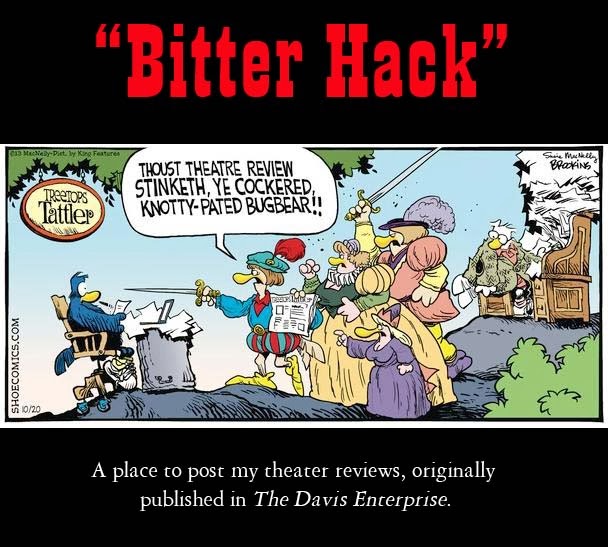With a little magic, a lot of fairy dust and some really strong overhead wires, “Peter Pan” bursts through the nursery window of the Wells Fargo Pavilion to thrill children and adults in this week’s first-rate Music Circus production of the J.M. Barrie classic.
The Tony Award-winning 1998 version, which also was made into an A&E TV special, is directed by Glenn Casale, with delightful choreography by Patti Colombo and additional flying-sequence choreography by Paul Rubin.
Three of the actors in this Music Circus production also were part of the A&E production — Paul Schoeffler (Mr. Darling/Captain Hook), Michael Nostrand (Smee) and Kim Arnett, a member of the ensemble.
Jenn Colella, recently co-starring with Idina Menzel on Broadway in “If/Then,” is an energetic Peter Pan — brash, physical, petulant, endearing. She has the swagger of a young boy, and flies through the air with the greatest of ease, sprinkling fairy dust in her wake.
The Darling children, who fly with Peter to Neverland, are Aidan Winn as John, Joshua Davis as Michael and Lori Eve Marinacci as Wendy. Winn is adorable, clutching his teddy bear in his footed jammies. Davis has a Harry Potter-ish appearance with his big glasses. Marinacci is a warm and caring Wendy, ready to be mother to the lost boys of Neverland, until she realizes that she really needs her own mother.
Jennifer Hope Wills is Mrs. Darling, who sings the children a beautiful lullaby (“Tender Shepherd”). Her husband is played by Paul Schoeffler, who also plays Captain Hook.
Schoeffler, who is returning to Music Circus after a long hiatus, has a long performing history with the group. He is simply marvelous, particularly as Hook, roaring orders at everyone, but reduced to a quivering mass of fear when faced with his nemesis, the crocodile, who has already bitten off one hand and wants to come back for the other.
The crocodile (Jake DuPree) is very realistic (and terrifying). DuPree is also the guy inside the Nana the Dog costume back in the nursery and is as believable as a dog as he is as a crocodile.
Michael Nostrand plays Hook’s right-hand man, Smee, the perfect sycophant ready to serve Hook at the drop of a hat.
Colombo’s choreography is outstanding, particularly the dances for the Indians, led by the Indian Princess Tiger Lily (Desiree Davar). Each of the Indian dances was a show-stopper, particularly the somewhat less-than-politically correct “Ugg-a-Wugg.” (Many believe the song employs outdated stereotypes about the American Indian language and culture, both musically and lyrically, and the lyrics were changed for the recent TV special).
Politically correct or not, this drum-infused dance number brought down the house on opening night.
The plot of the frenetic life on Neverland seems to be that the Indians hate the lost boys, as do the pirates, who also hate the Indians. It seems that everyone is chasing everyone at one time or another, though “Ugg-a-Wugg” celebrates a new liaison between Indians and Boys after Peter Pan rescues Tiger Lily from a rock where she was left by the pirates to die.
Suffice to say there is a lot of running and chasing and yelling and the kids in the audience loved it. I personally would have liked the volume of the sound, which can be ear-splitting, be turned down a smidge, but this is a show for the kids, not for grumpy adults.
Special kudos must be given to the ever-efficient Music Circus tech crew, who did yeomen’s duty hauling big set pieces on and off the stage in the dark. Scenic designers Scott Klier and Jamie Kumpf have done a great job particularly in creating the nursery with its overhead shelves lined with toys.
It’s hard to do a bad production of this popular story, and this version by the Music Circus is definitely popular with everyone in the audience, which had a high number of children.




